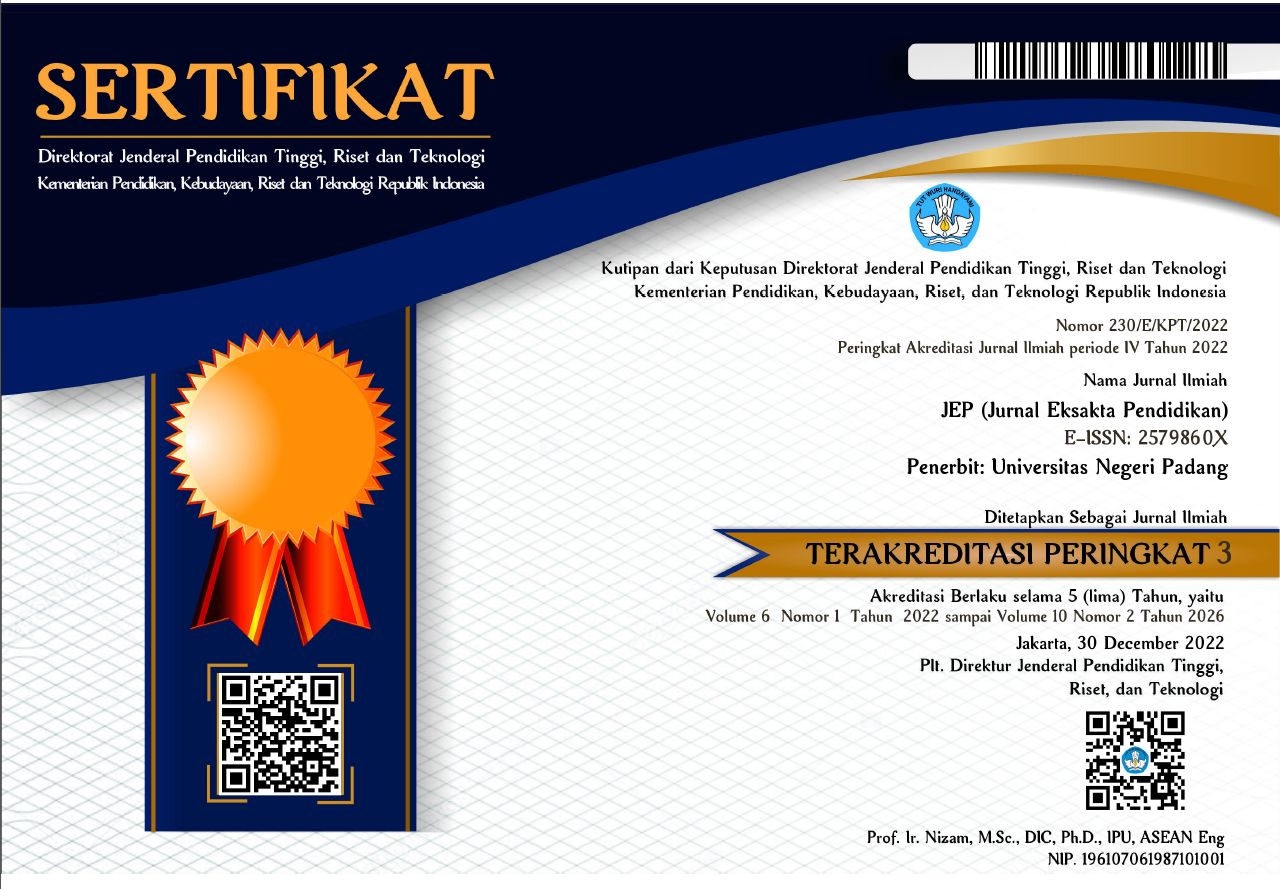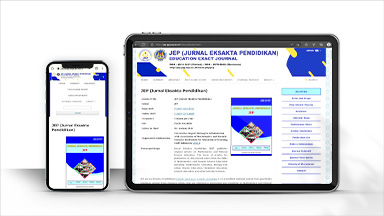The Effect of the Somatic, Auditory, Visual, Intellectual (SAVI) Approach to Improve Students' Critical Thinking Skills on the Material of Work and Energy
Abstract
This study is motivated by students' low critical thinking skills in the material of work and energy and the lack of innovation in using approaches in learning Physics. Based on the initial test, it is known that the average percentage of students' Critical Thinking Skills (CTS) in physics is 30%, with a very low category. The effort made by the researcher to overcome this problem was to apply the Somatic, Auditory, Visual, and Intellectual (SAVI) learning approach. The purpose of this study was to determine the effect of the SAVI learning approach on students' critical thinking skills and to determine the improvement of students' critical thinking skills after implementing the SAVI approach in class X MIPA SMA Negeri 2 Singaparna Academic Year 2022/2023. The research method used is a quasi-experiment with a non-equivalent control group design. The population of this study was the entire X MIPA class of SMA Negeri 2 Singaparna. The research sample was taken using a purposive sampling technique. Data analysis techniques used include normality test, homogeneity test, hypothesis test, and N-Gain test. Based on the results of hypothesis testing at the level of significance (α = 0.05), it found > (1.97> 1.67) so that is accepted. The experimental class N-Gain test results obtained data 0.54 in the medium category. It means that the SAVI approach affects students' CTS, and SAVI facilitates students to increase their CTS.
Downloads
References
Arikunto, S. (2020). Prosedur Penelitian Suatu Pendekatan Praktik. [Research Procedures A Practical Approach] Jakarta: Rineka Cipta.
Agustyaningrum, N. (2010). Implementasi Model Pembelajaran Learning Cycle 5e Untuk Meningkatkan Kemampuan Komunikasi Matematis Siswa Kelas IX B SMP Negeri 2 Sleman [Implementation of Learning Cycle 5e Learning Model to Improve Mathematical Communication Ability of Class IX B Students of SMP Negeri 2 Sleman]. Yogyakarta: Fakultas Matematika Dan Ilmu Pengetaahuan Alam. Universitas Negeri Yogyakarta. https://eprints.uny.ac.id/7389/
Chang, K dan Zhang, L. (2015). The Effects of Corporate Ownership Structure on Environmental Performance-Empirical Evidence from Unbalanced Penal Data in Heavy-Pollution Industries in China. WSEAS Transactions on systems and control Vol 10, ISSN 2224-2856.
Ennis, R. H. (1993). Critical Thinking Assessment. Theory into Practice, 32(3), 179-186. DOI: 10.1080/00405849309543594
Ermayanti, & Sulisworo, D. (2016). Tingkat Kemampuan Berpikir Kritis Peserta Didik setelah Penerapan Model Pembelajaran Student Team Achievement Divisions (STAD) pada Siswa Sekolah Menengah Atas (SMA) [The Level of Critical Thinking Ability of Learners after the Application of Student Team Achievement Divisions (STAD) Learning Model in Senior High School Students]. Prosiding Seminar Nasional Quantum, 175–181. https://eprints.uad.ac.id/7665/1/73-296-1-PBQuantum4.pdf
Fadli, A. R. (2019). Pengaruh Model Pembelajaran Problem Solving Laboratory Terhadap Kemampuan Berpikir Kritis Dan Hasil Belajar Fisika Siswa di MAN 2 Banyuwangi [The Effect of Problem Solving Laboratory Learning Model on Critical Thinking Ability and Student Physics Learning Outcomes at MAN 2 Banyuwangi]. (Skripsi). Universitas Jember. https://repository.unej.ac.id/handle/123456789/91535
Fauziyah, A. (2019). Pengaruh Pendekatan SAVI (Somatic, Auditory, Visual, Intellectual) Terhadap Kemampuan Berpikir Kreatif Pada Materi Sistem Pencernaan Kelas V di SD Negeri Serua Indah 02 [The Effect of SAVI (Somatic, Auditory, Visual, Intellectual) Approach on Creative Thinking Ability on Digestive System Material for Grade V at SD Negeri Serua Indah 02]. (Skripsi). Universitas Islam Negeri Syarif Hidayatullah. https://repository.uinjkt.ac.id/dspace/handle/123456789/49515
Fitriani, Suwarta., & Kusmariyatni. (2015). Pengaruh Model SAVI Terhadap Kemampuan Berpikir Kritis Siswa dalam Mata Pelajaran IPA Kelas 5 SD [The Effect of SAVI Model on Students' Critical Thinking Ability in Science Subjects of Grade 5 Elementary School]. Universitas Pendidikan Ganesha. Singaraja. https://ejournal.undiksha.ac.id/index.php/JJPGSD/%20article/view/5682
Giancoli, D. C. (2001). Fisika Edisi Kelima Jilid 1 [Physics Fifth Edition Volume 1]. Jakarta: Erlangga.
Haerudin. (2013). Pengaruh Pendekatan SAVI terhadap Kemampuan Komunikasi dan Penalaran Matematik serta Kemandirian Belajar Siswa SMP [The Effect of SAVI Approach on Communication and Mathematical Reasoning Ability and Learning Independence of Junior High School Students.]. Jurnal Ilmiah Program Studi Matematika STKIP Siliwangi Bandung. http://www.e-journal.stkipsiliwangi.ac.id/index.php/infinity/article/view/34
Hayati, D. S. (2017). Belajar dan Pembelajaran Berbasis Cooperative Learning [Learning and Learning Based on Cooperative Learning]. Magelang: Graha Cendekia.
Idrus. (2019). Evaluasi Dalam Proses Pembelajaran [Evaluation in the Learning Process]. ADARA: Jurnal Manajemen Pendidikan Islam. Vol: 9, No: 2. 2019. https://jurnal.iain-bone.ac.id/index.php/adara/article/view/427
Meier, D. (2002). The Accelerate Learning Handbook. United States Amerika: The McGraw-Hill Companies.
Nafisah, Y.N. (2014). Penerapan Model Problem-Based Learning Untuk Meningkatkan Keterampilan Berpikir Kritis dan Hasil Belajar Siswa [Application of Problem-Based Learning Model to Improve Critical Thinking Skills and Student Learning Outcomes]. Jurnal Pendidikan Vokasi. Universitas Negeri Yogyakarta. http://journal.uny.ac.id/index.php/jpv/article/view/2540
Nasution, M.I. (2017). Pengaruh Pendekatan SAVI (Somatic, Auditory, Visual, Intellectual) Terhadap Kemampuan Berpikir Kritis Siswa Pada Materi Koloid [The Effect of SAVI Approach (Somatic, Auditory, Visual, Intellectual) on Students' Critical Thinking Ability on Colloidal Material]. (Skripsi). Universitas Islam Negeri Syarif Hidayatullah. https://repository.uinjkt.ac.id/dspace/handle/123456789/36048
Ngalimun. (2017). Strategi pendidikan [Education strategy]. Bantul Yogyakarta: Prama ilmu
Nurhayati. (2014). Peningkatan Kemampuan Berpikir Kritis Siswa dalam Pembelajaran IPS Melalui Pendekatan SAVI Model Pembelajaran Berbasis Masalah [Improving Students' Critical Thinking Skills in Social Studies Learning Through SAVI Approach Problem Based Learning Model]. UNY. Yogyakarta. https://eprints.uny.ac.id/23884/
Nurmahmuddin, A., Nana, N., Rizal, R. (2023). The influence of e-module based on guided inquiry learning model on students’ critical thinking skills in the topic of work and energy. Gravity: Jurnal Ilmiah Penelitian dan Pembelajaran Fisika. 9 (2), 144-154. https://dx.doi.org/10.30870/gravity.v9i2.17801
Prihatmojo, A., Agustin, I. M., Ernawati, D., & Indriyani, D (2019). Implementasi Pendidikan Karakter Di Abad 21 [Implementation of Character Education in the 21st Century]. Seminar Nasional Pendidikan: Fakultas Ilmu Pendidikan Universitas Muhamadiyah Jakarta. https://jurnal.umj.ac.id/index.php/SEMNASFIP/article/download/5125/3407
Putra, H. D. (2013). Pembelajaran Geometri dengan Pendekatan SAVI Berbantuan Wingeom untuk Meningkatkan Kemampuan Generalisasi Matematis Siswa SMP [Learning Geometry with SAVI Approach Assisted by Wingeom to Improve Mathematical Generalization Ability of Junior High School Students]. (Thesis) STKIP Siliwangi, Bandung. http://repository.upi.edu/9469/
Rizal, R., Rusdiana, D., Setiawan, W., Surahman, E., & Ridwan, I. M. (2021). Digital literacy and cognitive abilities of preservice physics teacher in physics for school course using
LMS3 : how are the both correlated? J. Phys.: Conf. Ser. 2098 012011. doi: 10.1088/1742-6596/2098/1/012011
Rizal, R., Rusdiana, D., Setiawan, W., & Siahaan, P. (2022). Learning Management System supported smartphone (LMS3): Online learning application in Physics for school course to enhance digital literacy of preservice Physics teacher. Journal of Technology and Science Education, 12(1), 191-203. http://dx.doi.org/10.3926/jotse.1049
Rokhman, & Onik F. N. (2020). Metode Problem Solving, Minat Belajar, dan Pengalaman Belajar terhadap Kemampuan Berpikir Kritis [Problem Solving Method, Learning Interest, and Learning Experience on Critical Thinking Ability]. Jurnal Penelitian dan Pendidikan IPS (JPPI) 14(2). https://ejournal.unikama.ac.id/index.php/JPPI/article/view/4864
Rosmasari, A.R. & Supardi, Z.A.I. (2021). Penerapan Model Pembelajaran Problem Based Learning (PBL) untuk Meningkatkan Keterampilan Berpikir Kritis Peserta Didik pada Materi Usaha dan Energi Kelas X MIPA 4 SMAN 1 Gondang [Application of Problem Based Learning Model (PBL) to Improve Critical Thinking Skills of Students on the Material of Work and Energy Class X MIPA 4 SMAN 1 Gondang.]. PENDIPA Juournal of Science Education 5(3). https://ejournal.unib.ac.id/pendipa/article/view/15800
Setiadi, M. W. (2017). Pengembangan Modul Pembelajaran Biologi Berbasis Pendekatan Saintifik Untuk Meningkatkan Hasil Belajar Siswa [Development of Biology Learning Module Based on Scientific Approach to Improve Student Learning Outcomes]. Jurnal Of Education Science and Technology 2 (3). https://ojs.unm.ac.id/JEST/article/view/3468
Setyawan, W. A. & Yoyo S. (2015). Upaya meningkatkan keterampilan berpikir kritis melalui pendekatan SAVI (Somatis, Audiotori, Visual, Intelektual) [Efforts to improve critical thinking skills through the SAVI approach (Somatic, Audiotory, Visual, Intellectual)]. Prosiding Seminar Nasional, Pascasarjana Universitas Negeri Surabaya. https://eprints.uny.ac.id/21910/1/27%20Wahyu%20Aris%20Setyawan%20%26%20Yoyok%20Susatyo.pdf
Subali, P. D. B. (2017). Metodologi Penelitian Pendidikan Biologi dan Pendidikan Sains pada Umumnya [Research Methodology for Biology Education and Science Education in General]. (Tesis) Universitas Negeri Yogyakarta, Yogyakarta. http://library.fmipa.uny.ac.id/opac/index.php?p=show_detail&id=14701&keywords=
Sudjana. (2005). Metoda Statistika [Statistical Methods]. Bandung: Tarsito
Sudjana, I. W. C. (2019) Fungsi dan tujuan Pendidikan Indonesia [Functions and objectives of Indonesian education]. ADI WIDYA: Jurnal Pendidikan Dasar, 4(1).
Sugiyono. (2017). Statistika untuk Penelitian [Statistics for Research]. Bandung: Alfabeta.
Sugiyono. (2019). Metode Penelitian Kuantitatif, Kualitatif, dan R&D (2nd ed.) [Quantitative, Qualitative, and R&D Research Methods (2nd ed.)]. Bandung: Alfabeta.
Sulisworo, E. D (2016). Tingkat kemampuan berpikir kritis peserta didik setelah penerrapan model pembelajaran student team achievement divisions (STAD) pada siswa sekolah menengah atas (SMA) [The level of critical thinking skills of students after the application of the student team achievement divisions (STAD) learning model in senior high school students]. Prosiding seminar Nasional Quantum, (pp. 175-181). https://eprints.uad.ac.id/7665/
Sulviani, O., Muslimin, M., & Pasaribu, M. (2016). Pengaruh Peer Instruction dalam Model Pembelajaran Inkuiri Terbimbing terhadap Keterampilan Berpikir kritis pokok bahasan usaha dan energi siswa SMAN 2 Sigi [The Effect of Peer Instruction in Guided Inquiry Learning Model on Critical Thinking Skills on the subject of work and energy of students of SMAN 2 Sigi]. Jurnal Pendidikan FisikaTadulako (JPFT). Vol: 4, No: 3, 2016. http://jurnal.untad.ac.id/jurnal/index.php/EPFT/article/view/13558
Sumarsaid, R., Ibrahim, L., & Yani, M. (2020). Penerapan Pendekatan SAVI (Somatic, Auditory, Visual, Intellectual) terhadap Kemampuan Berpikir Kreatif Matematis [Application of SAVI (Somatic, Auditory, Visual, Intellectual) Approach to Mathematical Creative Thinking Ability]. Jurnal Ilmiah Pendidikan dan Pembelajaran: Universitas Muhammadiyah Aceh. Vol: 7, No: 2, 2020. http://www.cbt.unmuha.ac.id/index.php/pedagogik/article/view/824
Sundari, P. D., & Rimadani, E. (2020). Peningkatan Penalaran Ilmiah Siswa melalui Pembelajaran Guided Inquiry Berstrategi Scaffolding pada Materi Suhu dan Kalor [Improving Students' Scientific Reasoning through Guided Inquiry Learning with Scaffolding Strategy on Temperature and Heat Material]. Jurnal Eksakta Pendidikan (JEP), 4(1), 34. https://doi.org/10.24036/jep/vol4-iss1/402
Susanti, E., Septiana, S. ., Meilinda, S. ., & Rosa, I. M. . (2023). The Effectiveness of Using Google Sites-Based E-Modules to Optimize Critical Thinking Skills: Student Perceptions Analysis. Jurnal Penelitian Pendidikan IPA, 9(12), 10555–10561. https://doi.org/10.29303/jppipa.v9i12.5887
Suyatno. (2009). Menjelajah Pembelajaran Inovatif [Exploring Innovative Learning]. Sidoarjo: Masmedia Buana Pustaka
Thersia, V, Arifudin, M., & Misbah. (2019). Meningkatkan Kemampuan Pemecahan Masalah Melalui Pendekatan Somatis Auditori Visual Intelektual (SAVI) dengan Pengajaran Langsung [Improving Problem Solving Ability through Somatic Auditory Visual Intellectual (SAVI) Approach with Direct Teaching]. Berkala Ilmiah Pendidikan Fisika, pp. 19-27. https://ppjp.ulm.ac.id/journal/index.php/bipf/article/view/5638/0
Sumawardani, W. & Chairil (2013). Efektivitas Model Pembelajaran SAVI dalam pembelajaran matematika untuk mengembangkan karakter mandiri siswa [Effectiveness of SAVI Learning Model in mathematics learning to develop students' independent character]. EDU-MAT Jurnal Pendidikan Matematika, 1: 85. https://ppjp.ulm.ac.id/journal/index.php/edumat/article/view/576
Wijayanti, S. & Joko S. (2017). Pengembangan Pembelajaran berbasis SAVI [SAVI-based Learning Development]. Jurnal Tadris UIN Raden Intan Lampung, Vol. 8, No.2.
Yulia, N. W., et al (2016). Pengaruh Model Pembelajaran SAVI Terhadap Minat Belajar Matematika Siswa Kelas IV SD Mutiara Singa Raja [The Effect of SAVI Learning Model on the Interest in Learning Mathematics of Fourth Grade Students of Mutiara Singa Raja Elementary School]. Jurnal PGSD Vol: 4, No: 1, 2016. https://ejournal.undiksha.ac.id/index.php/JJPGSD/article/view/6982
Zubaidah, S. (2019). Mengenal 4C: Learning and Innovation Skills untuk Menghadapi Era Revolusi Industri 4.0 [Getting to Know 4C: Learning and Innovation Skills to Face the Era of Industrial Revolution 4.0]. Seminar 2nd Science Education National Conference Di Universitas Trunojoyo, (October 2018), 1–18. https://g.co/kgs/N8UNhd2
Copyright (c) 2024 Syifa Ulpiah, Rahmat Rizal

This work is licensed under a Creative Commons Attribution 4.0 International License.

This work is licensed under a Creative Commons Attribution 4.0 International License.




_(2579-860X).png)
_(2614-1221)1.png)




